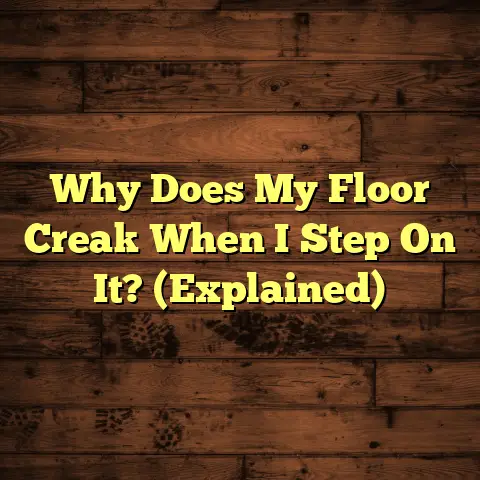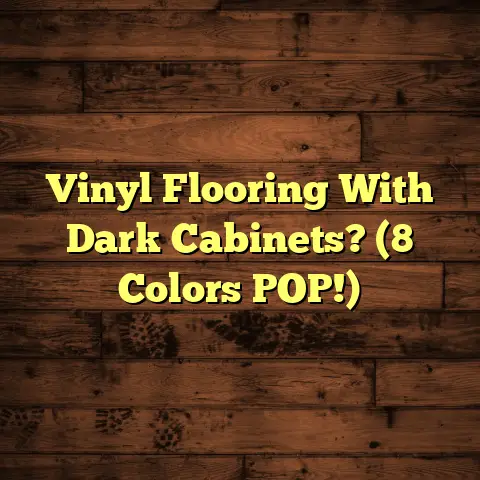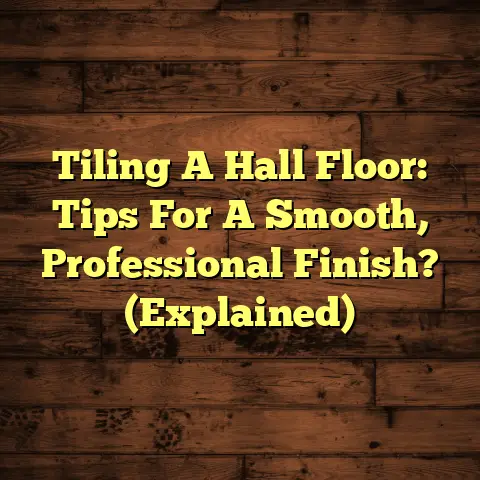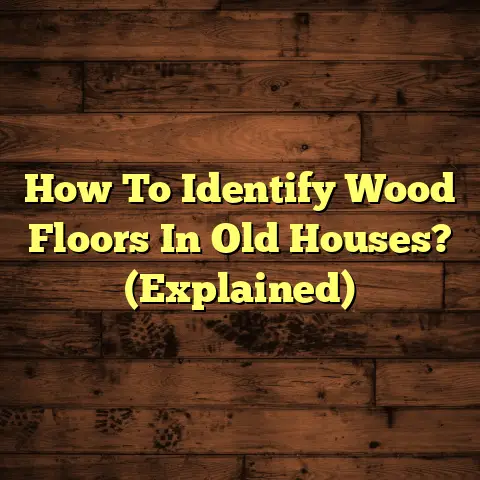Light Vs Dark Wood Floors: Which To Choose? (2 Options!)
Choosing the right flooring is a big deal – it’s not just about looks, it’s about your wallet too. We’re talking about initial costs, installation headaches, and long-term maintenance that can either save you a fortune or drain your bank account.
Let’s be real, nobody wants to throw money down the drain, right?
So, how much are we actually talking about? Well, for solid hardwood, you’re generally looking at anywhere from $8 to $15 per square foot installed. Engineered wood, a fantastic alternative, can range from $6 to $12 per square foot installed.
These are average prices, and of course, the specific wood species you choose makes a huge difference. For instance, you might pay less for a light-colored maple compared to a dark, exotic hardwood like Brazilian walnut.
I’ve seen homeowners boost their home’s value significantly by choosing flooring that resonates with potential buyers. Think about it: a well-maintained, stylish floor is a major selling point.
Durability is key. A floor that needs constant refinishing is going to cost you way more in the long run. Some finishes are more resilient than others, so it’s worth doing your homework.
In the end, it’s about finding that sweet spot where aesthetics, durability, and cost-effectiveness meet.
Ready to get started? Let’s dive in!
Section 1: Overview of Light Wood Floors
Definition and Characteristics
So, what exactly are we talking about when we say “light wood floors”? Think airy, bright, and open. Popular choices include maple, birch, ash, and even lighter stains on oak.
These woods naturally have a lighter tone, and they do an amazing job of reflecting light, making smaller spaces feel larger and more inviting.
I’ve walked into countless homes where light wood floors have completely transformed the atmosphere. They create a sense of calm and openness that’s hard to beat.
Cost Analysis
Alright, let’s talk numbers. For light wood floors, the cost breakdown looks something like this:
- Materials: $3 – $8 per square foot (depending on species and grade)
- Installation: $3 – $7 per square foot (depending on complexity)
- Finishing: $1 – $3 per square foot (for staining and sealing)
So, all in, you’re looking at roughly $7 to $18 per square foot installed. Now, keep in mind that these are just averages. Prices can fluctuate based on your location, the specific contractor you hire, and any unexpected subfloor repairs that might pop up.
Maintenance and Longevity
Here’s the good news: light wood floors tend to hide scratches and dents better than their darker counterparts. Dust and pet hair are also less noticeable, which is a huge win for busy households!
However, they can be susceptible to fading from prolonged sun exposure, so UV protection is a must.
Regular cleaning involves sweeping or vacuuming to remove debris, followed by occasional damp mopping with a wood-floor-specific cleaner.
Refinishing? Depending on the wear and tear, you might need to refinish every 7-10 years to keep them looking their best.
Market Trends
Light wood floors are definitely having a moment right now. They align perfectly with the minimalist, Scandinavian-inspired designs that are so popular.
They also appeal to buyers who are looking for a bright, airy, and modern aesthetic.
I’ve noticed that homes with light wood floors tend to sell faster and sometimes even command a slightly higher price, especially in markets where contemporary design is in demand.
Section 2: Overview of Dark Wood Floors
Definition and Characteristics
Now, let’s switch gears and explore the world of dark wood floors. We’re talking rich, dramatic tones that exude elegance and sophistication. Think walnut, cherry, mahogany, and dark-stained oak.
These floors create a sense of warmth and luxury, making a bold statement in any room.
I’ve always been drawn to the way dark wood floors anchor a space, adding a touch of drama and visual interest.
Cost Analysis
Dark wood floors often come with a slightly higher price tag, especially if you’re considering exotic hardwoods. Here’s a general cost breakdown:
- Materials: $5 – $12 per square foot (depending on species and grade)
- Installation: $3 – $7 per square foot (similar to light wood)
- Finishing: $1 – $3 per square foot (staining dark can sometimes require more coats)
Expect to pay around $9 to $22 per square foot installed. The higher cost is often attributed to the rarity and demand for certain dark wood species.
Maintenance and Longevity
Dark wood floors require a bit more TLC. They tend to show dust, scratches, and pet hair more readily, so regular cleaning is essential.
Sunlight can also be a major issue, causing the color to fade over time. UV-resistant finishes and window treatments are crucial to protect your investment.
Refinishing might be needed every 5-8 years, depending on the amount of traffic and wear.
Market Trends
Dark wood floors have been a classic choice for decades, and they’re still popular in traditional and contemporary homes. They can add a touch of formality and sophistication that appeals to certain buyers.
However, it’s worth noting that lighter floors are trending upwards, so it’s important to consider your target market and the overall style of your home.
I’ve seen dark wood floors work wonders in homes with high ceilings and ample natural light, creating a stunning and dramatic effect.
Section 3: Comparative Analysis
Cost-Effectiveness Comparison
Okay, let’s get down to brass tacks. Which is more cost-effective: light or dark wood floors?
Honestly, it depends.
Here’s a table summarizing the key cost factors:
| Feature | Light Wood Floors | Dark Wood Floors |
|---|---|---|
| Initial Cost | Lower to Mid-Range | Mid-Range to Higher |
| Maintenance | Easier, Hides Imperfections | Requires More Frequent Cleaning |
| Refinishing | Less Frequent | More Frequent |
| Longevity | High | High |
Here’s the deal: while dark wood might have a higher initial cost, the long-term cost can even out if you’re diligent about maintenance and protect them from sunlight.
Aesthetic Considerations
Aesthetics are subjective, but they play a HUGE role in your decision. Light wood floors create a bright, airy, and modern feel, while dark wood floors offer a more traditional, elegant, and dramatic look.
Think about your existing decor and the overall style of your home.
Here are some examples:
- Light Wood: Complements Scandinavian, minimalist, and coastal styles.
- Dark Wood: Pairs well with traditional, contemporary, and luxurious designs.
Ultimately, the best choice is the one that makes you happy and complements your personal style.
Environmental Impact
Sustainability is a growing concern for many homeowners, and it’s worth considering the environmental impact of your flooring choice.
Look for woods that are certified by the Forest Stewardship Council (FSC), which ensures that they come from responsibly managed forests.
Generally, locally sourced woods are more eco-friendly because they reduce transportation emissions.
Conclusion of Comparative Analysis
So, which flooring type is more cost-effective? It’s a tough call.
Light wood floors tend to have a lower initial cost and require less maintenance, but dark wood floors can add a touch of luxury and sophistication that some buyers are willing to pay a premium for.
Ultimately, the best choice depends on your budget, your personal style, and your long-term goals.
Don’t forget to factor in your lifestyle. If you have kids or pets, light wood floors might be a more practical choice due to their ability to hide imperfections.
Section 4: Case Studies
Case Study 1: Home with Light Wood Floors
I recently worked on a home renovation project where we installed light maple floors throughout the main living areas.
The homeowners were looking for a bright, modern, and airy feel.
- Total Cost: $12,000 (for 1,500 square feet)
- Aesthetic Appeal: The light floors completely transformed the space, making it feel larger and more inviting.
- Buyer Feedback: The homeowners received rave reviews from potential buyers, who loved the clean and contemporary aesthetic.
Case Study 2: Home with Dark Wood Floors
On another project, we installed dark walnut floors in a formal dining room and living room.
The homeowners wanted to create a sense of elegance and sophistication.
- Total Cost: $18,000 (for 1,500 square feet)
- Aesthetic Appeal: The dark floors added a touch of drama and luxury to the space.
- Resale Insights: While some buyers loved the dark floors, others found them to be too formal or overwhelming.
Comparative Reflection
These case studies highlight the importance of considering your target market and the overall style of your home.
Light wood floors tend to appeal to a broader range of buyers, while dark wood floors can be more polarizing.
In terms of long-term financial implications, the home with light wood floors might have a slight advantage due to lower maintenance costs and broader appeal.
Conclusion
Choosing between light and dark wood floors is a big decision, and it’s important to weigh the financial aspects carefully.
Consider the initial costs, maintenance requirements, and long-term value.
Remember, your personal style and future resale potential should also factor into your decision.
Ultimately, the right flooring can significantly impact the overall atmosphere and value of your home. So, take your time, do your research, and choose the option that best fits your needs and preferences.
Good luck, and happy flooring!





